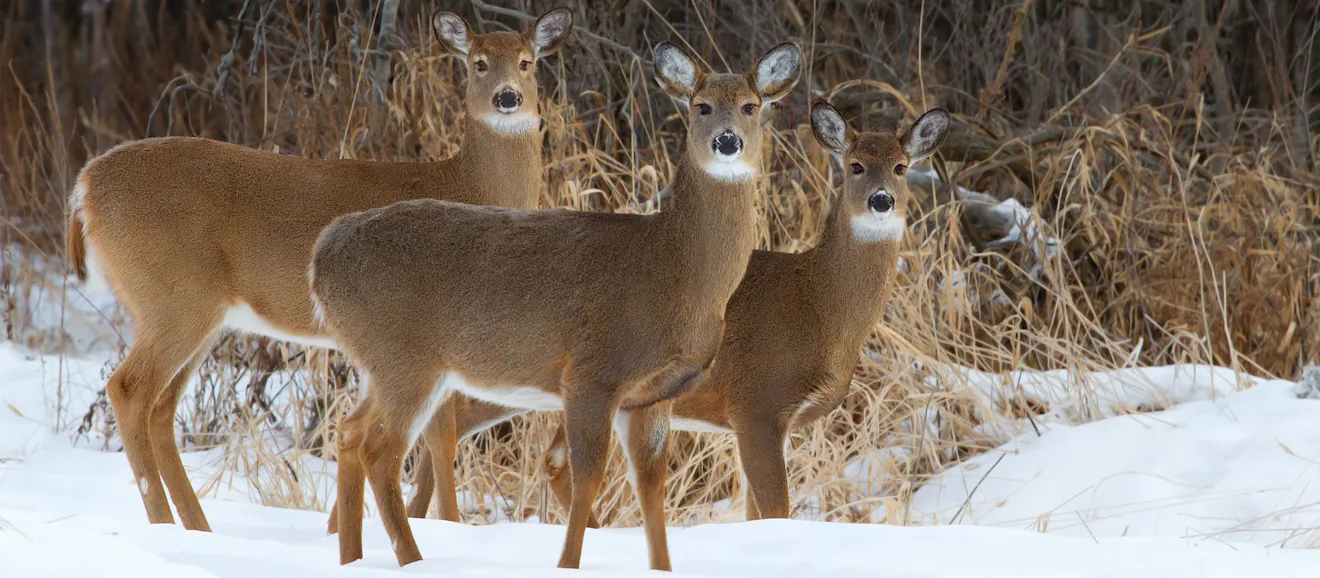When winter weather hits hard, you almost can’t help but wonder how deer get through the worst of it. It’s not just us hunters who ponder their fates, either; just about anyone who sees deer slogging through the snow or bracing against a cold wind is apt to ask themselves, What do deer eat in the winter, and do they need our help to make it through till spring? I know the answers to these questions, and I still wonder sometimes.
Feeding deer, and other wildlife, is among the strongest compulsions for anyone vested in the outdoors, and during winter, the temptation is nearly irresistible. More and more hunters are turning to winter nutrition plots to satisfy the urge to help, but many others want to feed deer with offerings of shelled corn, hay, or even pellets designed for deer. So, the questions are, should we feed deer and, if so, what?
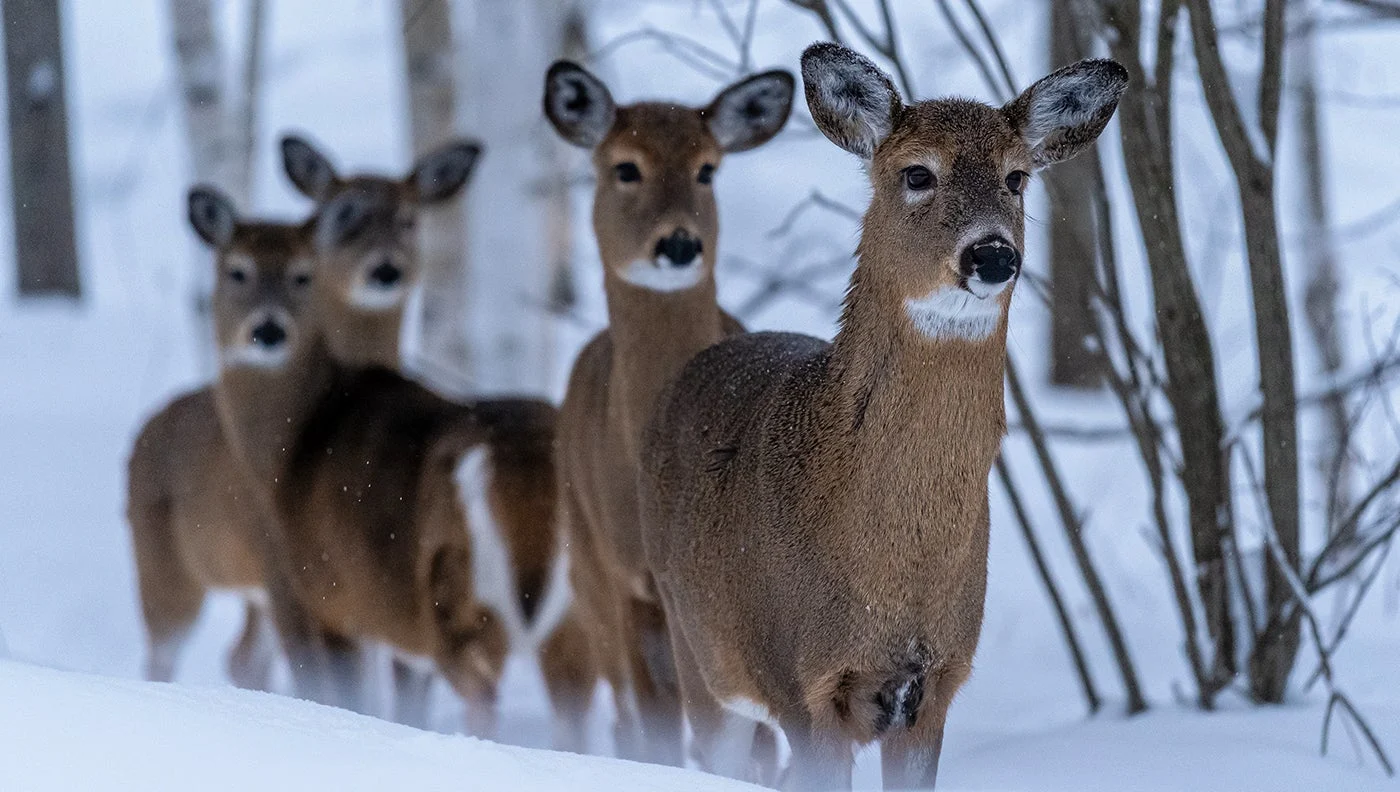
A group of does follows a well-used trail through deep snow to get to a food source.
Table of Contents
What Do Deer Eat in the Winter? At a Glance
What Do Deer Eat in the Winter Without Our Help
Favorite Winter Whitetail Foods
Winter Survival Foods for Deer
What Are the Effects of Harsh Winters on Deer?
Should You Feed Deer?
The Best Ways to Help Deer in Winter
When Times Get Really Tough
FAQs
What Do Deer Eat in the Winter, At a Glance?
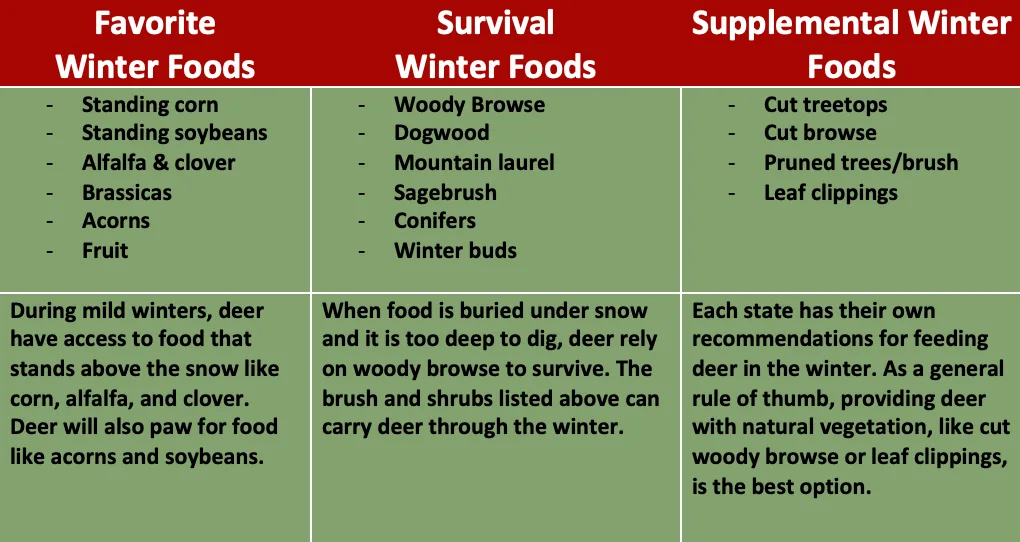
Related: 36 Foods Every Deer Hunter Should Know About
What Do Deer Eat in the Winter Without Our Help?
Well, the good news is that deer—whether they are blacktails on the West Coast, mule deer in the Rockies, or whitetails in virtually every other place—are wonderfully adapted to surviving winter. So if you’re wondering what do deer eat in the winter, the answer is: a virtual salad bar of woody browse, which their systems are designed to not only digest, but to wring out every last drop of nutrition. Deer will even turn to some evergreen species to get through, and while these slim picking may not scream “feast” to our ears, deer have been surviving winter by eating pretty much nothing but buds and twigs for millennia.
Favorite Winter Whitetail Foods

That said, the pickings are not always slim now. In many areas, especially during mild winters, deer have access to some of their favorite foods that are either standing up above the snow or are accessible with a little pawing or digging. Here are some choice winter foods for deer:
Standing Corn: There are plenty of years when wet weather prevents farmers from harvesting certain cornfields, which are left standing and provide a boon to winter deer. Corn is also a common winter food plot if you can keep deer out of it until cold weather comes.
Standing Soybeans: Same goes for soybeans, and if the snow isn’t too deep, deer will paw it away to get to waste grain in both corn and bean fields.
Alfalfa and Clover: These crops often grow tall enough to stick up through the snow in winter, providing one of the few green food sources available now. Deer will dig through snow to get to both. The same can be said for cereal grains if the snow isn’t deep, as well as naturally growing grasses and forbs.
Brassicas: Brassica food plots get hammered all winter, as long as there are tall green leaves for deer to eat and roots in the ground to dig for.
Acorns: Again, as long as the snow isn’t too deep, deer will dig for acorns all winter long.
Fruit: Late-bearing fruit is a treat for deer, and they also browse on the buds and twigs of fruit trees.
Young Woody Browse: In the big woods, a regenerating clearcut may not look like a buffet to you, but it does to a deer.
Winter Survival Foods for Deer
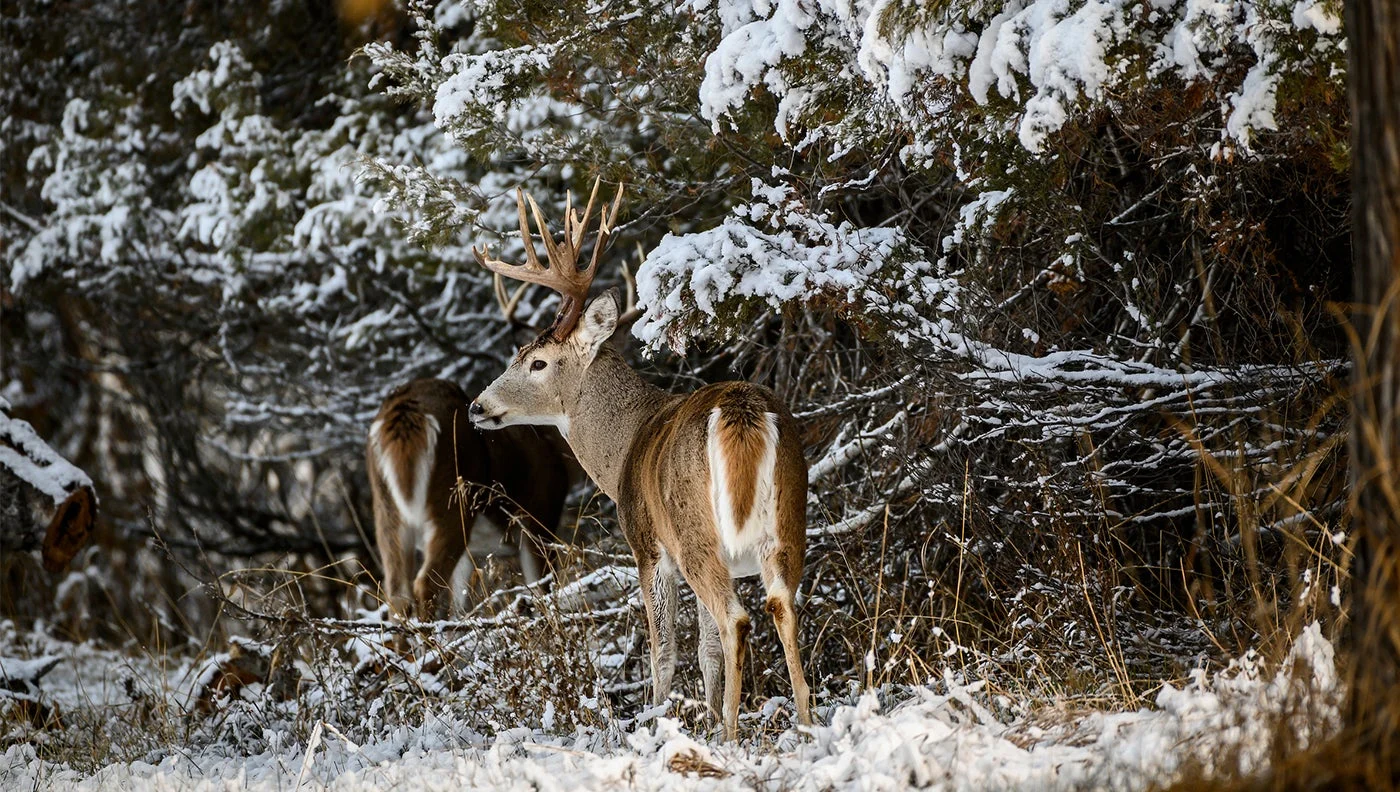
When snow is too deep for deer to effectively dig for ground-level foods, or too deep for them to travel extensively to reach more favored foods, they are pretty much stuck with woody browse. The good news is that the list of shrub and bush and tree species that deer can eat in winter is too long to list here. Some of the most common and favored include ash, aspen, bitterbrush, blackgum, dewberry, dogwood, greenbrier, hickory, honeysuckle, maple, mountain laurel, oak, popular, sagebrush, sumac, willow, and more. When times are tough, deer will also turn to coniferous species including cedar, Douglas fir, hemlock, balsam fir, and pine.
What Are the Effects of Harsh Winters on Deer?
It’s also important to note that deer simply require fewer calories in winter than they do in other months of the year. Deer metabolism ramps down significantly from the high-calorie requirements of spring and summer, when forage is lush and deer feed constantly. It’s amazing, really: From green-up through early fall, when does are nursing fawns and bucks are growing antlers (activities that require an abundance of high-quality food) deer are packing on fat. These reserves are, in a normal winter, enough to see them through until spring, thanks largely to reduced movement and a decided down-shift in metabolism.
That said, some deer are not going to make it through the winter. This has been Nature’s plan since deer (and other prey species) have existed. Fawns and younger deer are often the first to perish, as mature does and bigger-framed bucks will chase them off valuable winter foods. Grouped-up deer are also more vulnerable to predation by wolves, coyotes, bobcats, mountain lions, and feral dogs. And in a severe winter, when deep snows cover up remaining food sources and make travel difficult, and sub-zero temps erode the fat reserves needed to maintain core body temps, more deer will succumb to the extreme conditions.
Should You Feed Deer?
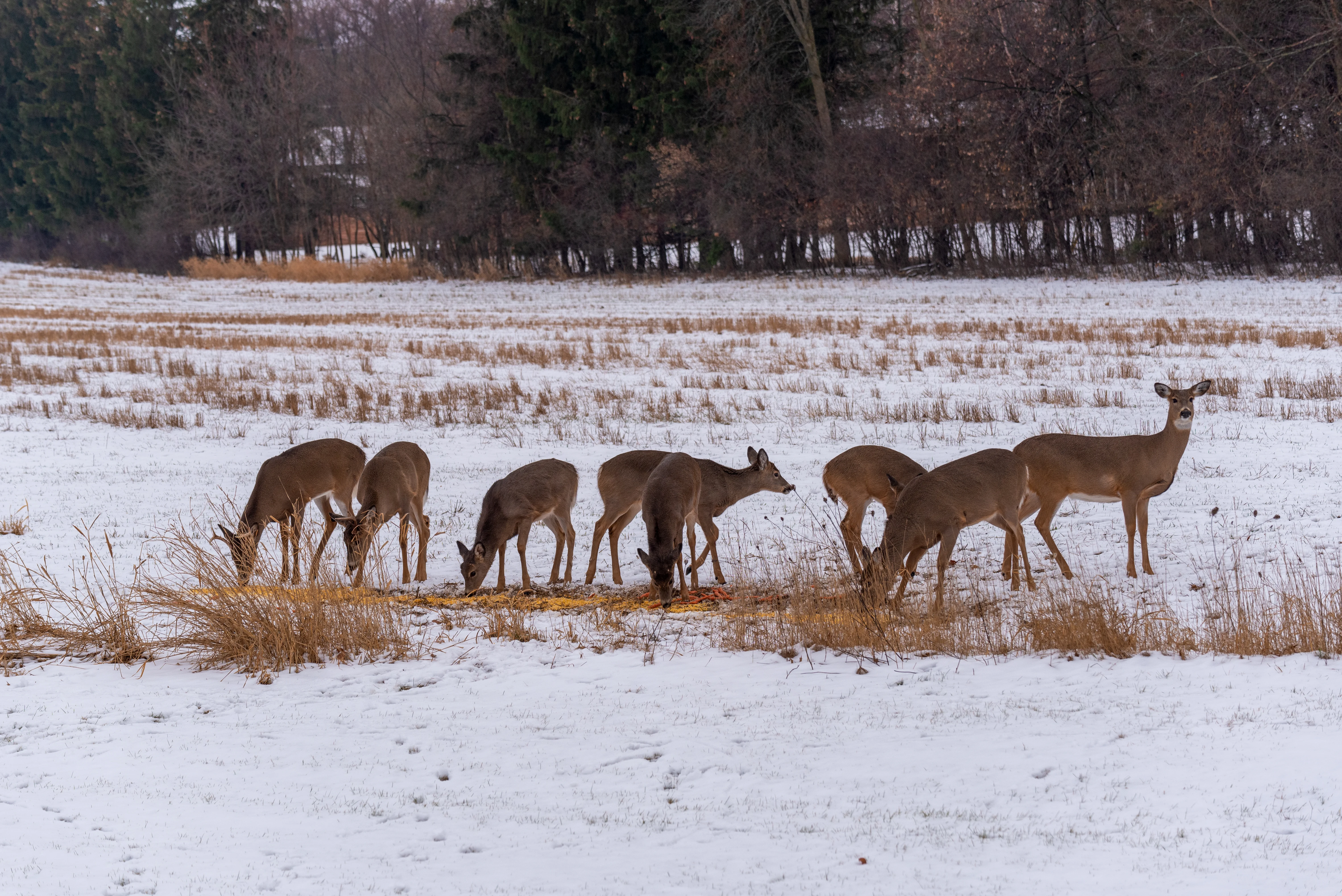
While winter die-offs due to starvation and predators have been part of deer biology for as long as they’ve been a species, that doesn’t mean such losses are easy to accept. It’s natural to want to rush out with bushel baskets full of goodies and come to the deer’s rescue. But artificial feeding, though well-intentioned, comes with its own set of problems, and there are things we can do that will help deer far more.
The Best Ways to Help Deer in Winter
Maintaining prime habitat and helping to manage the local deer herd can both go a long way toward insuring that deer can withstand even the harshest winter. Here are three things you can do for starters regarding the question of what do deer eat in the winter:
1. Timber Management
Logging that keeps at least portions of forest stands young and puts browse within easy reach of wintering deer is one of the best ways to “feed” deer when they need it most. Other chainsaw projects like hinge-cutting drops the tops of trees with low (or no) timber value to where deer can reach them, offering another a food source. This also provides horizontal cover that deer seek out for security.
2. Plant Browse Species and Winter Food Plots
Plantings that put deer food on the landscape for months are far more beneficial than random dumpings of corn or other foods. So, what should you plant? Go with shrub or tree species native to your area that deer love, or food plots that will not only keep deer well-fed in fall, but long into winter, too, like corn, soybeans, and brassicas.
3. Manage the Deer Herd
Keeping deer numbers in tune with the habitat will greatly reduce winter die-offs and starvation. The other normal inclination of people who love deer is wanting to see a lot of them, and some hunters (despite years of data proving otherwise) believe that having a ton of does somehow makes their hunting better and therefore refuse to shoot them. This is simply bad management if the habitat won’t support them. If you don’t recognize the basic signs of deer overpopulation (lack of regenerating trees and shrubs, well-defined browse lines, etc.), consult a biologist to determine an appropriate harvest for your property.
When Times Get Really Tough
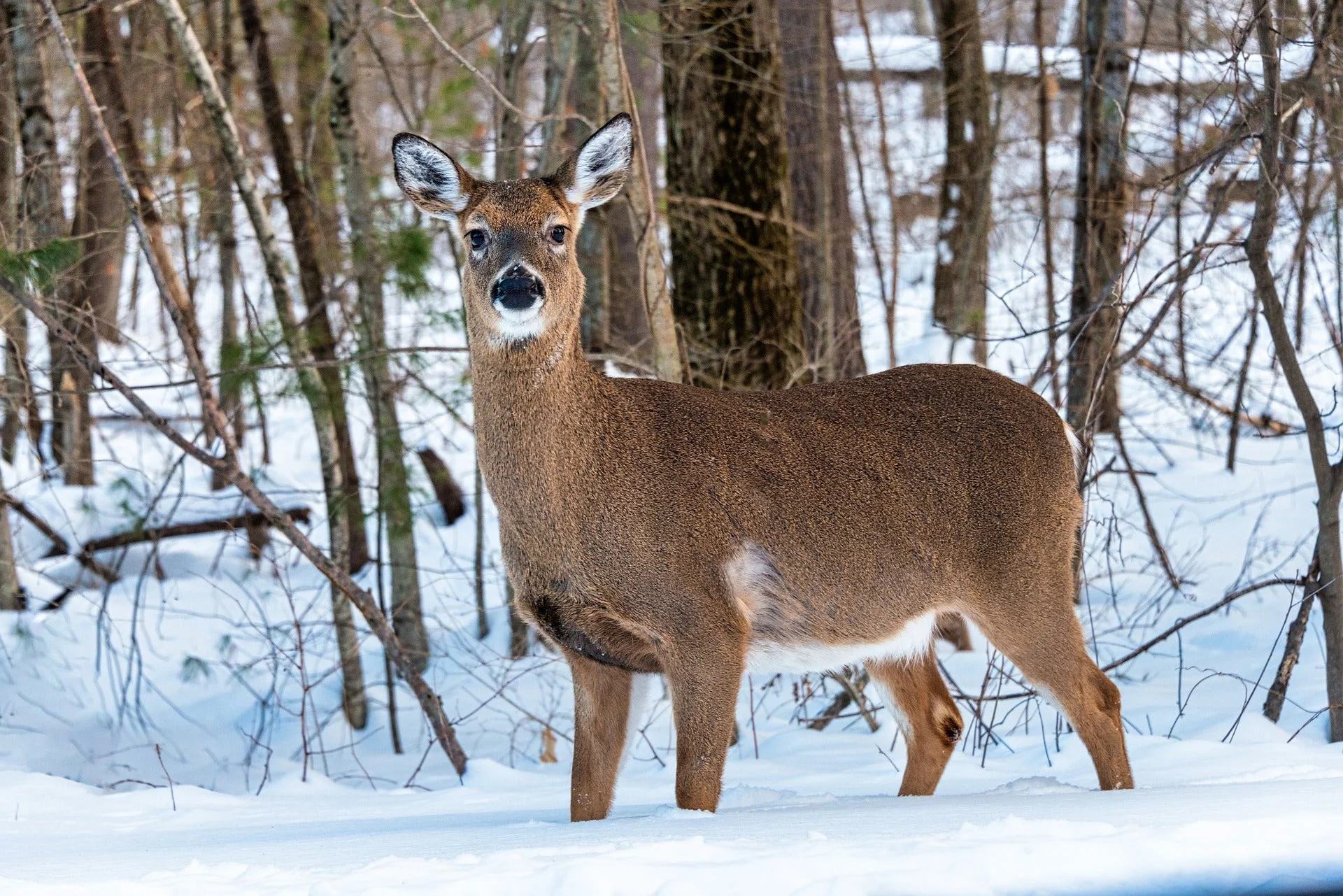
Of course, sometimes none of the above factors are within our control, and sometimes Nature throws us the hard-breaking curve of a massive winter. Shouldn’t we feed deer then? The answer is a definite “maybe.” While many state game agencies discourage, or outright ban, winter deer feeding, others engage in the practice. Still, many wonder what they can individually do to help deer through a tough winter.
According to the National Deer Association, it’s generally a bad idea to feed deer unless you either started weeks or months ago or you can offer the right stuff. And, of course, the right stuff shouldn’t come as a shock; the NDA recommends dropping or hinge-cutting trees to provide the fresh woody browse that deer are naturally seeking now, or to prune trees and brush and leave the clippings on the ground. But don’t seek deer to feed them; if you know where deer are wintering, do your best to stay away. Whitetails are trying to conserve energy during winter, and running away from you won’t help them one little bit.
So, what about the go-to quick-fix feeding options like shelled corn or hay? That too is generally a bad idea, according to Kip Adams, the NDA’s Education & Outreach Coordinator and a former state deer-program leader. While hungry deer will certainly gobble up your offerings, they might literally eat themselves to death; the whitetail gut is not designed to process such high-carb foods now, and deer can actually become poisoned when their systems are shocked by a sudden introduction. So, if you insist on using these foods, you should start offering it early; otherwise start with small amounts, spaced widely apart, to give deer time to adjust.
If you decide to feed winter deer, try to use the best methods outlined above, and commit yourself to the long haul. Remember that as nasty as the weather feels right now, this is not the hardest time of the year for deer. That comes in March, when fat reserves are largely gone and deer are as weak as they’ll be all year. If you’re not willing to go the distance with them, it’s probably best to not start at all.
FAQs
Q: What not to feed deer in the winter?
According to the National Deer Association, it’s generally a bad idea to feed deer unless you either started weeks or months ago or you can offer the right stuff. It is all right to cut treetops, brush, leaves, and other natural vegetation and leave them out for deer to feed on.
Q: What do deer eat in the wild?
Deer prefer to feed on corn, soybeans, alfalfa, clover, acorns, fruit, brassicas, and woody browse. They will also feed on shrubs, including ash, aspen, bitterbrush, blackgum, dewberry, dogwood, greenbrier, hickory, honeysuckle, maple, mountain laurel, oak, popular, sagebrush, sumac, willow, and more.
Q: What do deer eat in the winter in Ontario?
Deer will look for natural foods like corn, acorns, woody browse, and shrubs as they would in any other location. But Ontario also has specific guidelines for feeding deer.

